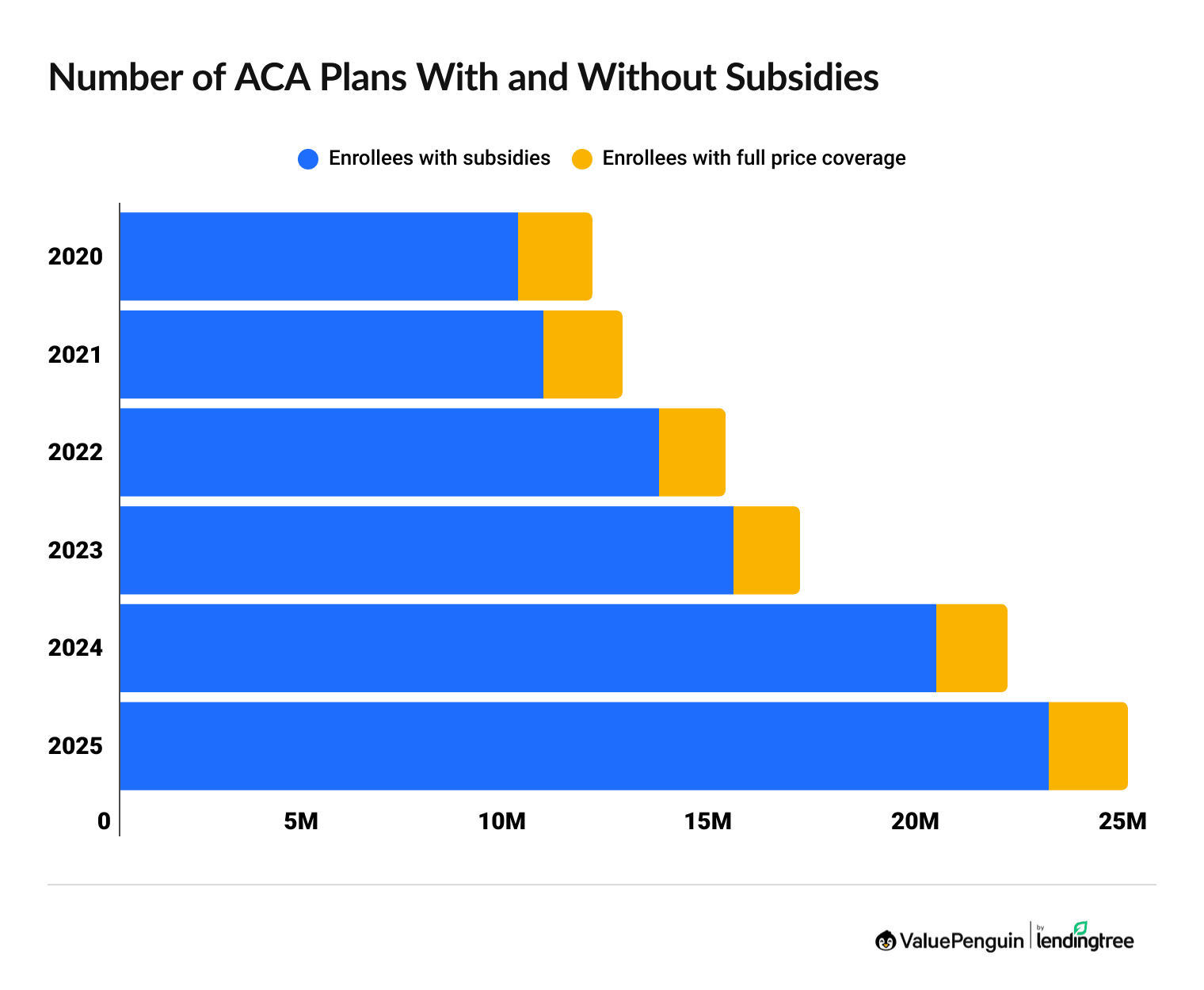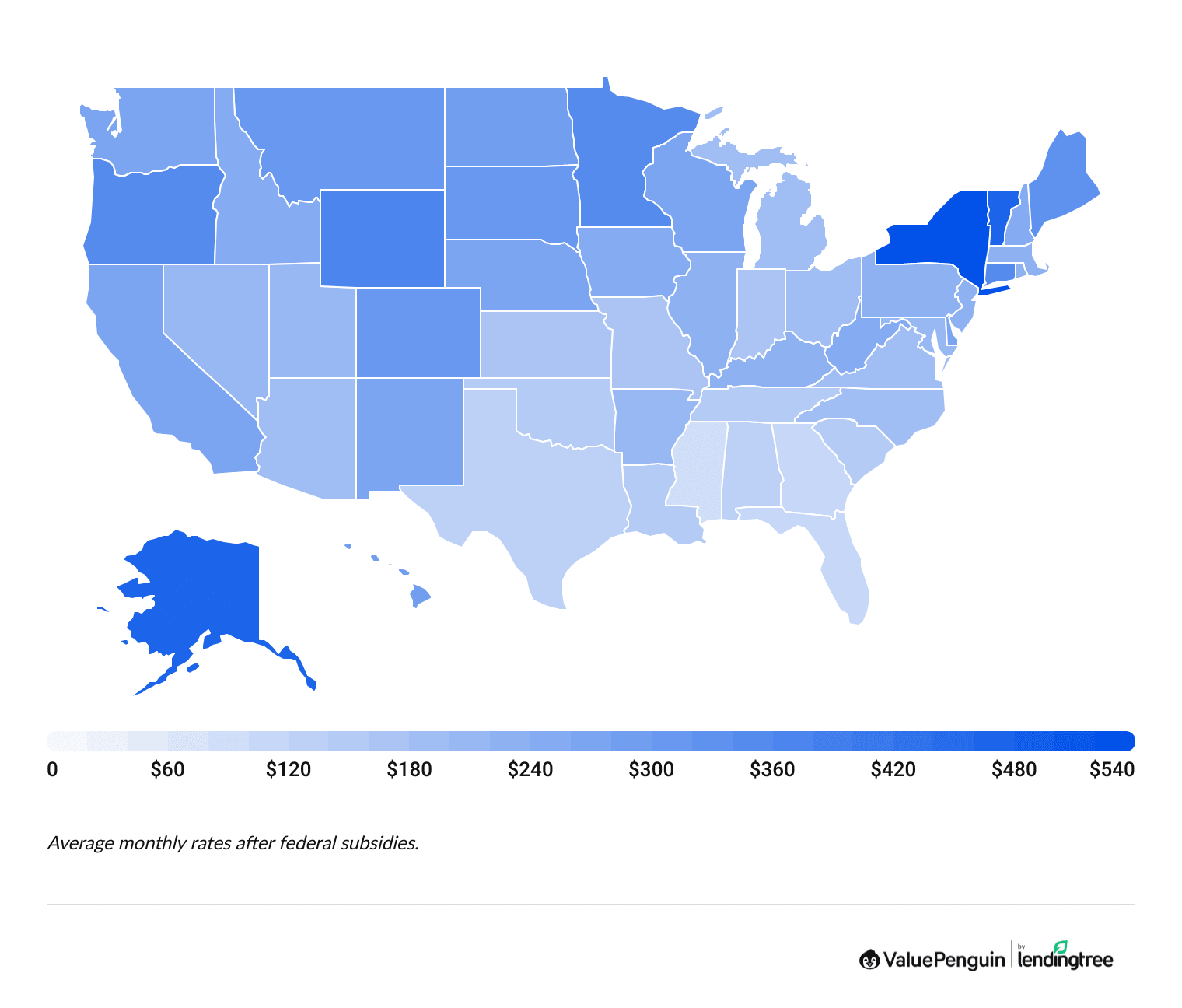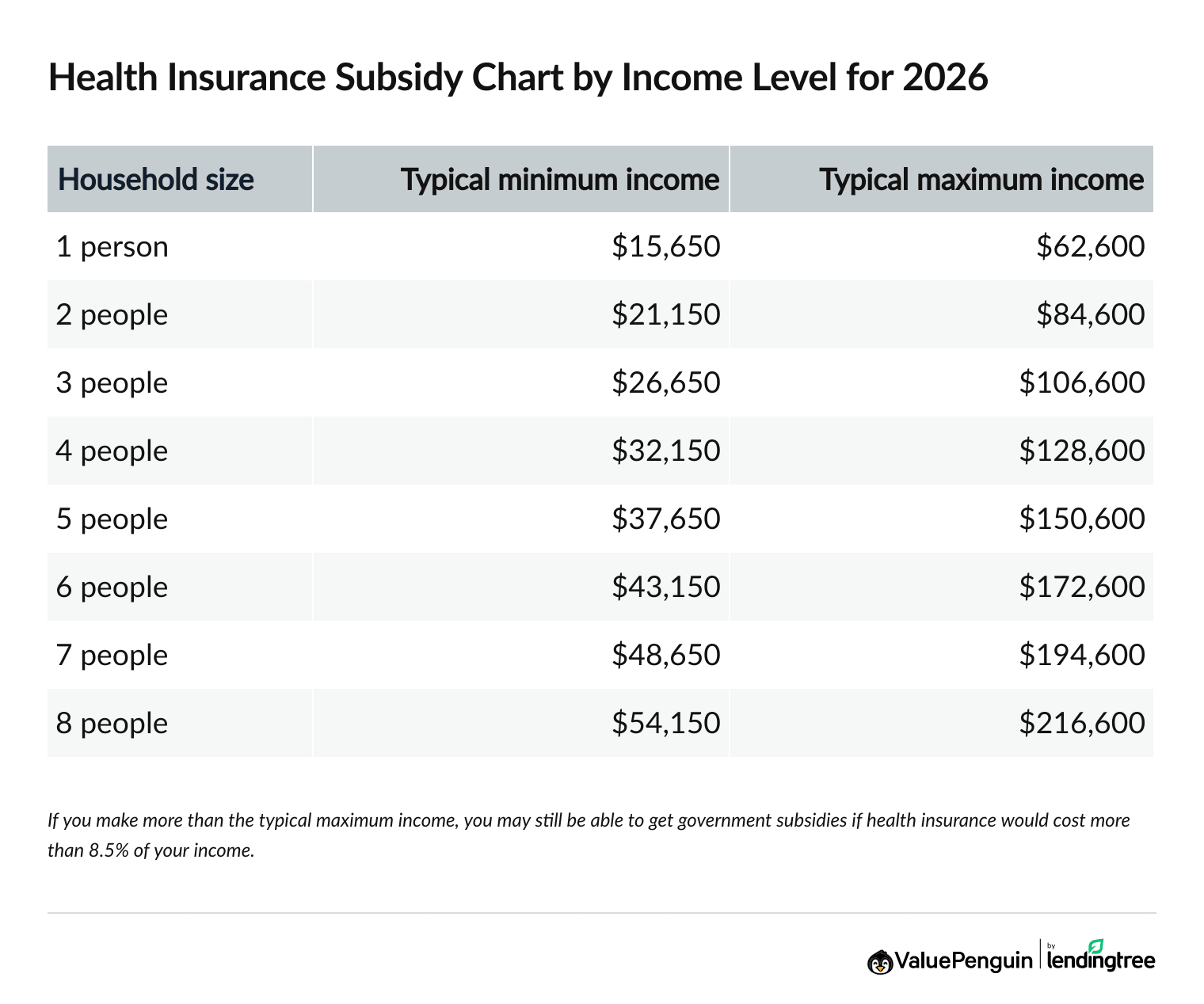Obamacare / ACA Subsidy Calculator
Health Insurance Subsidy Calculator
Calculate your ACA health insurance savings for your income and state.
Your health insurance estimated subsidy
Per person
Income vs. federal poverty level
0%
Your cost for a Silver plan
$0/month
Your cost without the subsidy
$0/month
Find Cheap Health Insurance in Your Area
Estimate your ACA subsidy to see how much health insurance could cost you every month.
After you enter your ZIP code and income, you'll see your estimated subsidy for this year and how much you'll potentially pay for health insurance from HealthCare.gov or a state marketplace.
Pandemic-era "enhanced subsidies" will expire at the end of 2025. That means health insurance will cost more in 2026 than in years past.
What are ACA subsidies?
As part of the Affordable Care Act (ACA), ACA subsidies (also called "Obamacare" subsidies) give you tax credits that help you pay less for a health insurance plan you buy from an ACA marketplace.
- How it works: Subsidies lower the cost of private health insurance based on the size of your family and your household income. You can use them to lower your monthly bill or your taxes at the end of the year.
- Who can sign up: If you make too much to qualify for Medicaid, but your income is still low, you can sign up on HealthCare.gov or your state’s health insurance marketplace and potentially get subsidies.
- Which insurance plans qualify: ACA subsidies can lower the cost of any company’s Bronze, Silver, Gold or Platinum plans. But you can’t use them on Catastrophic plans, Medicaid, the Children's Health Insurance Program (CHIP) or coverage from a job.

The number of people with marketplace coverage has grown steadily between 2020 and 2025. But, fewer people are projected to get Obamacare health insurance in 2026.
That's because expiring "enhanced subsidies," higher health care costs and more expensive prescription drugs are causing the average cost of health insurance to rise by 21% nationwide in 2026.
Obamacare enrollment with and without subsidies
Year | Subsidized plans | Unsubsidized plans |
|---|---|---|
| 2020 | 9.6 million | 1.8 million |
| 2021 | 10.2 million | 1.9 million |
| 2022 | 13 million | 1.6 million |
| 2023 | 14.8 million | 1.6 million |
| 2024 | 19.7 million | 1.7 million |
Find Cheap Health Insurance in Your Area
What is the income limit for marketplace insurance?
In 2026, you'll likely be eligible for ACA subsidies if you earn between $15,650 and $62,600 as a single person.
A family of four is eligible with a household income between $32,150 and $128,600.
For most people, health insurance subsidies are available if your income is between one and four times the federal poverty level (FPL). The table below shows the income range based on household size that you have to fall into to qualify for ACA health insurance subsidies in 2026.
Obamacare subsidy income limits for 2026
Household size |
Typical min. income
|
Typical max. income
|
|---|---|---|
| 1 person | $15,650 | $62,600 |
| 2 people | $21,150 | $84,600 |
| 3 people | $26,650 | $106,600 |
| 4 people | $32,150 | $128,600 |
| 5 people | $37,650 | $150,600 |
Between 2021 and 2025, you wouldn't have to pay more than 8.5% of your income on your monthly rate with a marketplace plan regardless of how much you make. Starting in 2026, you can't get subsidies if you make more than $62,600 per year as a single person ($128,600 for a family of four) in most of the country.
If you live in New Jersey, you may be able to get subsidies with an income of up to $93,900 as an individual ($192,900 for a family of four) because of special state-level subsidies.
If you earn less than $15,650 as an individual ($32,150 for a family of four), you can't get ACA subsidies.
But you are usually eligible for Medicaid, which provides cheaper health insurance than you can get with a marketplace subsidy.
If you can get Medicaid because of your income, you can't get marketplace subsidies.
In most states, there's an overlap between Medicaid and subsidy qualifications.
For example, you can usually get Medicaid if you make up to $21,597 per year as a single person (or less than $44,367 per year for a family of four). And the typical minimum income for subsidies is $15,650 per year for an individual ($32,150 per year for a family of four). If you're in the gap between $15,650 and $21,597 ($32,150 to $44,367 per year for a family of four), and you qualify for Medicaid, then you can't get subsidies. You can still buy a marketplace plan if you don't want Medicaid, but you'll have to pay full price.
Medicaid is harder to get in 10 states. In these states, you usually have to have a very low income and meet another requirement, like having a disability or being pregnant. You can probably get marketplace subsidies at the lower end of the income spectrum in these states.
Calculating your ACA subsidies
Before shopping for an ACA health insurance plan, you can estimate your health insurance costs by using the subsidy calculator or doing the math yourself. Knowing if you can get a subsidy and how much it will be can help you choose a plan that best fits your needs.
How much you might save depends on your income, your family size and the cost of what's called a benchmark Silver plan where you live. When it comes to the amount of the subsidy you can get, the less you earn, the larger your subsidy.
You'll start by figuring out how much you earn compared to the federal poverty level. For 2026 health insurance plans, you'll use your estimated 2026 income and compare that to the 2025 federal poverty level amounts. For example, if you're single with an income of $31,300 per year, you're earning twice the federal poverty level.
Alaska and Hawaii have different limits because they have higher costs of living.
Federal poverty level (FPL) for the continental U.S.
Hawaii
Alaska
Household size | Federal poverty level |
|---|---|
| 1 person | $15,650 |
| 2 people | $21,150 |
| 3 people | $26,650 |
| 4 people | $32,150 |
| 5 people | $37,650 |
For a family of nine or more, add $5,500 for each extra person.
Federal poverty level (FPL) for the continental U.S.
Household size | Federal poverty level |
|---|---|
| 1 person | $15,650 |
| 2 people | $21,150 |
| 3 people | $26,650 |
| 4 people | $32,150 |
| 5 people | $37,650 |
For a family of nine or more, add $5,500 for each extra person.
Hawaii
Household size | Federal poverty level |
|---|---|
| 1 person | $17,990 |
| 2 people | $24,320 |
| 3 people | $30,650 |
| 4 people | $36,980 |
| 5 people | $43,310 |
For families/households with more than 8 persons, add $6,330 for each additional person.
Alaska
Household size | Federal poverty level |
|---|---|
| 1 person | $19,550 |
| 2 people | $26,430 |
| 3 people | $33,310 |
| 4 people | $40,190 |
| 5 people | $47,070 |
For families/households with more than 8 persons, add $6,880 for each additional person.
The ACA limits the monthly price you spend on health insurance if you earn less than $62,600 per year as an individual ($128,600 per year for a family of four) in most states. In some states, you might be able to get discounts with a higher income. For example, in New Jersey, you can get financial help from the government if you earn less than $93,900 per year ($192,900 for a family of four).
Between 2021 and 2025, you wouldn't pay more than 8.5% of your income for marketplace coverage regardless of your level of income. This spending cap is going away in 2026. That means there's no limit on how much you'll pay for coverage if you make too much to qualify for ACA subsidies.
Your health insurance discount is tied to the cost of a "benchmark Silver plan," which is the second-cheapest Silver plan in your area. You can view available quotes in the federal or state insurance exchange to find the benchmark plan, or you can call the marketplace. HealthCare.gov can be reached at 800-318-2596. If your state uses a state marketplace site, check the website for a phone number.
If the amount you should pay for insurance is less than the cost of a benchmark plan, your subsidy will be the difference between the two. For example, if the benchmark Silver plan costs $3,000 a year and your income calculation means you should pay $1,000 for a plan, then you will get a subsidy of $2,000.
If your expected contribution for health insurance is more than the cost of a benchmark plan, you won't get any health insurance subsidies. However, you can still enroll in full-priced plans.
A person earning $31,300 (twice the federal poverty level) is expected to spend 6.6% of their income toward a typical health insurance plan. That amounts to about $172 per month.
If it costs $500 per month for a benchmark Silver plan, that person would get a subsidy of $328 per month to cover the difference. The $328 subsidy can be used for any Bronze, Silver, Gold or Platinum plan.
When can you sign up for ACA subsidies?
You can sign up for an ACA subsidized health insurance plan each year during the annual open enrollment period between Nov. 1 and Jan. 15. But if you have a qualifying life event, you may be eligible for a special enrollment period, which would give you access to get coverage midyear.
Examples of qualifying events include:
- Loss of health care coverage
- Changes in household
- Changes in residence
How much does health insurance cost after ACA subsidies?
The average cost of a subsidized health insurance policy in the U.S. is an estimated $175 per month.
How much you'll pay for health insurance is based on your income, your family size and where you live. You'll probably get smaller subsidies in 2026 because pandemic-era "enhanced subsidies" expire at the end of 2025.

Find Cheap Health Insurance in Your Area
In 2026, New York residents who get subsidies pay the highest average estimated rates for Obamacare after the discounts are applied, at $534 per month. Shoppers in Mississippi who get subsidies have the cheapest monthly rates in the country, averaging an estimated $85 per month after subsidies.
Average cost of health insurance after subsidies
If you qualify for a rate subsidy, you may also be eligible for another type of health insurance discount that helps you pay for doctor visits and prescription drugs, called a cost-sharing reduction. You can only get cost-sharing reductions if you choose a Silver health plan.
Do I have to pay back subsidies?
No, you don't have to pay back health insurance subsidies that you qualify for.
But there may be an adjustment at tax time, when your actual income for the year is used to determine if you got subsidies that were too large or too small.
Most people get subsidies every month in the form of what are called "advance premium tax credits." Since these discounts are based on your estimated income for the year, the actual subsidy amount you are eligible for might be different once you know your actual income when you file your taxes.
- If you qualify for more subsidies than you got, you'll get the extra amount as a tax credit when you file income taxes.
- If you got higher subsidies than you were ultimately eligible for, then you will have to repay some or all of the money you got as a subsidy when you file your taxes.
If your actual income doesn't match your estimated income at tax time, you will have to repay the entire difference in your subsidy amount.
Previously, if you had a lower income, you didn't always have to repay the full amount if you made more than you thought you would. There was a limit on the amount you had to pay back. However, a recent rule change means you have to pay back the full amount no matter how much you got. Starting with your 2026 income, if you make more than you expected to, you have to repay the full difference between the subsidy you should have gotten and the amount you actually got.
Are $6,400 subsidies for health insurance real?
Health insurance subsidies are real, but the advertisements for $6,400 subsidies are scams.
These ads are scams to get you to share your personal info. They are also misleading about how the subsidy program works. Health insurance subsidy amounts vary by household, and you have to shop through the government marketplace to be eligible.
Subsidy amounts change based on your income and location.
You have to shop in the government-run marketplace to get subsidies.
You'll never get a gift card or cash as a subsidy.
Claims that you must 'act now' are exaggerated.
It will probably take longer than the 30 seconds advertised.
Frequently asked questions
Is Obamacare free?
Obamacare health insurance usually isn't free, and those who get subsidies typically pay an estimated average of $175 per month. Obamacare might be free if you don't earn much, as costs are on a sliding scale based on your income. And those with very low incomes might be eligible for free insurance through Medicaid instead.
What are the income limits for health insurance subsidies?
To qualify for health insurance subsidies, you'll typically need to earn between $15,650 and $62,600 as a single person or between $32,150 and $128,600 as a family of four.
Who is eligible for Obamacare?
Most people who don't have health insurance through their job can buy an insurance plan through HealthCare.gov or their state health insurance marketplace. Your income determines if you can get health insurance subsidies. Use a subsidy calculator to estimate your final cost for health insurance.
How much is Obamacare insurance?
The average cost of health insurance through Obamacare is $752 per month for a single person. For those with low to moderate incomes, subsidies can reduce the cost of health insurance, and those who qualify pay an estimated average of $175 per month.
Methodology and sources
Costs and calculations are based on data from public use files (PUFs) on the Centers for Medicare & Medicaid Services (CMS) government website.
Subsidy calculator prices are estimates based on the cost for a 40-year-old with a Benchmark Silver plan. Benchmark Silver rates are from KFF. Your subsidy amount and rate will vary depending on your income, age and plan choices.
Other sources include HealthCare.gov, CMS.gov, KFF and the U.S. Department of Health & Human Services.
Insurance Writer
Cate Deventer is a ValuePenguin writer who specializes in health insurance, Medicare, auto and home insurance. She's been a licensed insurance agent since 2011.
She started her insurance career working as a customer service agent for State Farm. She later moved to an independent agency, where she worked with several insurance companies and hundreds of clients. She quoted policies, filed claims and answered insurance questions. In 2021, she pivoted her career and began writing about insurance for Bankrate. She moved to ValuePenguin in 2023 and began writing about health insurance and Medicare.
Cate has a passion for helping readers choose insurance to fit their needs. She enjoys knowing that her research and knowledge help people choose insurance products that make a positive difference in their lives.
How insurance helped Cate
Cate used her health insurance knowledge to navigate a surgery in 2023. Understanding how her policy worked let her focus on recovery instead of worrying about bills.
Expertise
- Health insurance
- Medicare & Medicaid
- Auto insurance
- Home insurance
- Life insurance
Credentials
- Licensed Life, Accident & Health Insurance Agent
- Licensed Property & Casualty Insurance Agent
Referenced by
- CBS
- NBC
- Wall Street Journal
Education
- BA, Theatre, Purdue University
- BA, English, Indiana University
Editorial note: The content of this article is based on the author's opinions and recommendations alone. It has not been previewed, commissioned or otherwise endorsed by any of our network partners.

